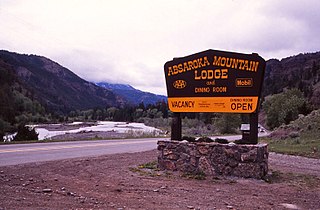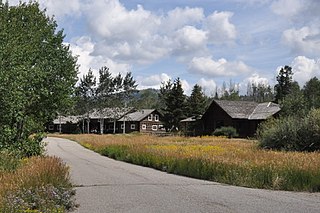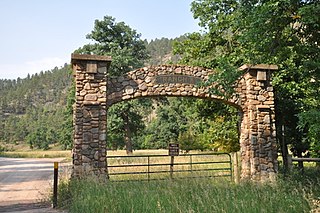
The Absaroka Mountain Lodge is a historic dude ranch located between Cody, Wyoming, and Yellowstone National Park in the Absaroka Mountains. The property in Shoshone National Forest was known as the Gunbarrel Lodge when it was established about 1917 by Earl F. Crouch. It received its enduring name in 1925, and was progressively expanded until the 1970s.

The Highlands Historic District in Grand Teton National Park is a former private inholding within the park boundary. The inholding began as a 1914 homestead belonging to Harry and Elizabeth Sensenbach, who began in the 1920s to supplement their income by catering to automobile-borne tourists. In 1946 the property was purchased by Charles Byron, Jeanne Jenkins and Gloria Jenkins Wardell, who expanded the accommodations by one or two cabins a year in a U-shaped layout around a central lodge. The lodge and cabins are constructed in a rustic log style, considered compatible with park architecture. The Highlands was neither an auto camp, which encouraged short stays, nor a dude ranch, which provided ranch-style activities. The Highlands encouraged stays of moderate length, providing a variety of relatively sedentary amenities. It was the last private-accommodation camp to be built in the park before the Mission 66 program created concessioner-operated facilities on public lands.

The 4 Lazy F Ranch, also known as the Sun Star Ranch, is a dude ranch and summer residence in Jackson Hole, Wyoming, built by the William Frew family of Pittsburgh in 1927. The existing property was built as a family retreat, not as a cattle ranch, in a rustic style of construction using logs and board-and-batten techniques. The historic district includes seven cabins, a lodge, barn corral and smaller buildings on the west bank of the Snake River north of Moose, Wyoming. The property was added to the National Register of Historic Places in 1990.

The Bar B C Dude Ranch was established near Moose, Wyoming in 1912 as a dude ranch by Struthers Burt and Dr. Horace Carncross, using their initials as the brand. Rather than converting a working ranch, Burt and Carncross built a tourist-oriented dude ranch from the ground up, using a style called "Dude Ranch Vernacular", which featured log construction and rustic detailing. As one of the first dude ranches in Jackson Hole, the Bar B C was a strong influence on other dude ranches in the area, and employed a number of people who went on to establish their own operations. It was acquired by the National Park Service and incorporated into Grand Teton National Park upon the expiration of a life estate. The ranch was listed on the National Register of Historic Places in 1990.

The AMK Ranch is a former personal retreat on the eastern shore of Jackson Lake in Grand Teton National Park. Also known as the Merymare, Lonetree and Mae-Lou Ranch, it was a former homestead, expanded beginning in the 1920s by William Louis Johnson, then further developed in the 1930s by Alfred Berol (Berolzheimer). Johnson built a lodge, barn and boathouse in 1927, while Berol added a larger lodge, new boathouse, and cabins, all in the rustic style.
Flat Creek Ranch, formerly a working ranch in Jackson Hole, Wyoming, is a guest ranch. The original ranch was established by Cal Carrington between 1901 and 1918 at the base of Sheep Mountain, also known as the "Sleeping Indian". In 1923 a new owner, socialite and journalist Cissy Patterson, built the present structures. The transition from working ranch to vacation retreat foreshadowed a movement of the Jackson Hole economy away from traditional ranching to tourism, which is documented by the Flat Creek Ranch.

The Ramshorn Dude Ranch Lodge in Grand Teton National Park was built after 1935 by mountaineers Paul Petzoldt, founder of the National Outdoor Leadership School, and Gustav Koven. The property that became the Ramshorn Ranch was originally established by Ransom Adams at the mouth of Gros Ventre Canyon near Ditch Creek. By 1921 the property was acquired by Jack and Dollye Woodsman, who established the Flying V dude ranch, featuring a large central lodge. In 1932 the lodge burned, prompting the Woodsmans to sell the ranch to Koven and Petzoldt in 1935, who planned to expand the dude ranch as a climbing school and hunting camp. Petzoldt withdrew from the partnership in 1937 after suggesting the name be changed to the Ramshorn Ranch. The present lodge was completed in 1937 by the Woodward brothers, who took over operation. A variety of owners and partners ensued until 1956, when the ranch was sold to the National Park Service. The Park Service then leased the ranch back to concessioners who operated it as the Elbo Ranch until 1973, replacing the former Elbo Ranch purchased by the Park Service. The Teton Science School was established on the property in 1974 under a special use permit.

The Manges Cabin in Grand Teton National Park, also known as the Old Elbo Ranch Homestead Cabin, Mangus Cabin and the Taggart Creek Barn, was built in 1911 by James Manges. Manges was the second settler on the west side of the Snake River after Bill Menor, setting up a homestead near Taggart Creek. James Manges arrived in Jackson Hole in 1910, where he cut wood for Charles or William Wort. Manges' cabin is stated to have been the first two-story structure in the northern part of the valley. A root cellar was excavated beneath. The log and frame structure features wide eaves to keep the winter snow away from the walls. It was heated in winter by a single stove, with one room on each level.

Leek's Lodge is part of a former resort and dude ranch in Grand Teton National Park, near Jackson Lake. The ranch was established to offer activities to boys in a frontier setting. Its founder, Steven N. Leek, was instrumental in the establishment of the National Elk Refuge in Jackson Hole. The rustic lodge was built in 1927.

The White Grass Dude Ranch is located in the White Grass Valley of Grand Teton National Park. The rustic log lodge, dining hall service building and ten cabins were built when a working ranch was converted to a dude ranch, and represented one of the first dude ranch operations in Jackson Hole. The White Grass was established in 1913 by Harold Hammond and George Tucker Bispham, who combined two adjacent ranches or 160 acres (65 ha) each, and was converted to a dude ranch in 1919. Bispham had worked at the Bar B C before moving out on his own. The dude ranch operation continued to 1985, when the ranch was acquired by the National Park Service.

The Hunter Hereford Ranch was first homesteaded in 1909 by James Williams in the eastern portion of Jackson Hole, in what would become Grand Teton National Park. By the 1940s it was developed as a hobby ranch by William and Eileen Hunter and their foreman John Anderson. With its rustic log buildings it was used as the shooting location for the movie The Wild Country, while one structure with a stone fireplace was used in the 1963 movie Spencer's Mountain. The ranch is located on the extreme eastern edge of Jackson Hole under Shadow Mountain. It is unusual in having some areas of sagebrush-free pasture.
The UXU Ranch is a historic dude ranch in Shoshone National Forest near Wapiti, Wyoming. The ranch began as a sawmill, as early as 1898. In 1929 Bronson Case "Bob" Rumsey obtained a permit from the U.S. Forest Service to operate a dude ranch on the property, using the sawmill headquarters building, a lodge, and tent cabins. Most of the current structures were built in the 1920s and 1930s from lumber milled on the site.
The Red Star Lodge and Sawmill, also known as the Shoshone Lodge, is a dude ranch in Shoshone National Forest near the east entrance to Yellowstone National Park. Built between 1924 and 1950, the ranch includes a rustic log lodge surrounded by cabins and support buildings. What is now called the Shoshone Lodge is the most intact example of a dude ranch operation in the area.
The Elephant Head Lodge is a dude ranch on the road to, and only 12 miles from, the east entrance of Yellowstone National Park, in Shoshone National Forest. The ranch includes two main lodges surrounded by support buildings and guest cabins. Beginning in 1926, the Elephant Head was developed by Buffalo Bill Cody's niece, Josephine Thurston and her husband Harry W. Thurston. The lodge was named after a distinctive rock formation that rises above the property.

The Vee Bar Ranch Lodge was built in 1891 as the home of Lionel C.G. Sartoris, a prominent Wyoming rancher. The ranch was later owned by Luther Filmore, a Union Pacific Railroad official, and the Wright family, who operated the ranch as a dude ranch. The property comprises five historic buildings including the lodge, original corral and a stock chute.

This is a list of the National Register of Historic Places listings in Park County, Wyoming.

Ranch A, near Beulah, Wyoming, was built as a vacation retreat for newspaper publisher Moses Annenberg. The original log ranch structures in Sand Creek Canyon were designed in the rustic style by architect Ray Ewing. The principal building, a large log lodge, was built in 1932. Other buildings constructed at the time included a garage with an upstairs apartment, a barn, a hydroelectric power plant, stone entrance arches and a pump house. The lodge was furnished with Western furniture and light fixtures made by noted designer Thomas C. Molesworth. Many of these furnishings, among the first of Molesworth's career, are now the property of the state of Wyoming and are in the Wyoming State Museum.

The historical buildings and structures of Grand Teton National Park include a variety of buildings and built remains that pre-date the establishment of Grand Teton National Park, together with facilities built by the National Park Service to serve park visitors. Many of these places and structures have been placed on the National Register of Historic Places. The pre-Park Service structures include homestead cabins from the earliest settlement of Jackson Hole, working ranches that once covered the valley floor, and dude ranches or guest ranches that catered to the tourist trade that grew up in the 1920s and 1930s, before the park was expanded to encompass nearly all of Jackson Hole. Many of these were incorporated into the park to serve as Park Service personnel housing, or were razed to restore the landscape to a natural appearance. Others continued to function as inholdings under a life estate in which their former owners could continue to use and occupy the property until their death. Other buildings, built in the mountains after the initial establishment of the park in 1929, or in the valley after the park was expanded in 1950, were built by the Park Service to serve park visitors, frequently employing the National Park Service Rustic style of design.

Medicine Lodge State Archeological Site is a Wyoming state park that interprets the Medicine Lodge Creek Site, a prehistoric Native American archeological site near Hyattville, Wyoming. It is administered by the Wyoming Division of State Parks and Historic Sites. The site is at the base of a steep limestone outcropping near the point where the dry and running portions of Medicine Lodge Creek join. for a protected location with ready access to water. The site includes petroglyphs and pictographs on the rock face. Excavations starting in the 1970s have found twelve levels of habitation in 10.5 feet of stratum, ranging from historic times to 8300 years before the present. The site comprises a portion of the former Wickwire Ranch, which was purchased by the state in 1972 and became to Medicine Lodge Wildlife Habitat Management Area of 12,000 acres (4,900 ha). The archeological site was designated in 1973. The site is managed as a state park, with campgrounds and a visitor center. It was added to the National Register of Historic Places on July 5, 1973.
T Cross Ranch is a dude ranch in Fremont County, Wyoming. The ranch is located at 7,800 feet (2,400 m) altitude in Shoshone National Forest, 15 miles (24 km) from Dubois and 2 miles (3.2 km) from the Washakie Wilderness. Apart from a cabin built by the site's original homesteader, the contributing buildings of the ranch date between 1916 and 1946. The ranch was established in 1918 by German immigrant Henry Seipt when he established his homestead and called it The Hermitage. Seipt and his family ran the ranch as a hunting and fishing camp until 1929, when it was sold to Robert and Helen Cox. The Coxes renamed it the T Cross Ranch and made it into a dude ranch. The new name was derived from the Tau Chapter of Saint Anthony's Society, to which Robert Cox had belonged at the Massachusetts Institute of Technology, and from the cross of St. Anthony. A total of 16 log buildings comprise the historic section of the ranch. The district also includes irrigation ditches dug during the 1920s and 1930s.
















